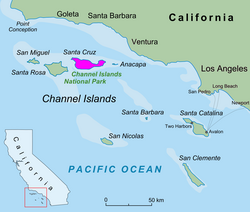Description
The island scrub jay is closely related to the California scrub jay (the coastal population found on the adjacent mainland), but differs in being larger, more brightly colored, and having a markedly stouter bill. They will bury, or cache, the acorns in the fall and may eat them months later. They also eat insects, spiders, snakes, lizards, mice and other birds' eggs and nestlings.
Taxonomy
The island scrub jay was first described by American ornithologist Henry Wetherbee Henshaw in 1886 [4] and an archaeological specimen at site SCRI-192 dating from the 1780s-1812 on Santa Cruz Island is the earliest evidence of the bird in the historic period. [5] This bird is a member of the crow family, and is one of a group of closely related North American species named as scrub jays. These were formerly treated as a single species, the scrub jay (as Aphelocoma coerulesens), with five subspecies, [6] but are now considered four species: the Florida scrub jay (A. coerulescens), the island scrub jay, the California scrub jay (A. californica), and Woodhouse's scrub jay (A. woodhouseii). DNA studies indicate that the island and coastal forms have long been isolated from their relatives inland. [7] The relationships within the genus have been studied in several papers (e.g. [8] )
Island scrub jays seem to be incapable of crossing to the mainland. However they were once present on three of California's northern Channel Islands, San Miguel Island, Santa Rosa Island, and Santa Cruz Island where they persist today. [9] Reliable historical observer records for island scrub jays in addition to Santa Cruz Island include only a single 1892 account on neighboring Santa Rosa Island, only about 10 km (6 mi) away. [5] The historic observation on Santa Rosa Island is supported by a Pleistocene archaeological record of a single island scrub jay femur from a Late Pleistocene-Holocene site (SRI-V-3) found by Paul Collins of the Santa Barbara Museum of Natural History. [5] There are also two Late Holocene archaeological remains found in San Miguel Island cave sites. [9] There are no definite occurrences of a scrub-jay on any other of the Channel Islands, or on the Coronado Islands, only 13 km (8 mi) from the mainland.
Early studies suggested that the ancestor of the present population was storm-borne or carried on driftwood to Santa Cruz, or that the colonization occurred during a period of glaciation 70,000 to 10,000 years ago, when sea levels were much lower and the channel between the coast and the islands was correspondingly narrower. [10] More recent DNA studies show that, although other island endemics such as the island fox and the Santa Cruz mouse may have diverged from their mainland relatives around 10,000 years ago, the scrub jays separated in a period of glaciation around 151,000 years ago. The most recent analysis indicates that the island scrub jay has been evolving in isolation for approximately one million years, [8] i.e. over multiple glacial cycles. Up to about 11,000 years ago, the four northern Channel Islands were one large island, so island scrub jays must have been present on all four islands initially, but became extinct on Santa Rosa, San Miguel and Anacapa after they were separated by rising sea levels. [11]
Etymology
The genus name, Aphelocoma, comes from the Latinized Ancient Greek apheles- (from ἀφελής-) "simple" + Latin coma (from Greek kome κόμη) "hair", in reference to the lack of striped or banded feathers in this genus, compared to other jays. The species name, insularis, comes from the Latin for "from an island".
This page is based on this
Wikipedia article Text is available under the
CC BY-SA 4.0 license; additional terms may apply.
Images, videos and audio are available under their respective licenses.



